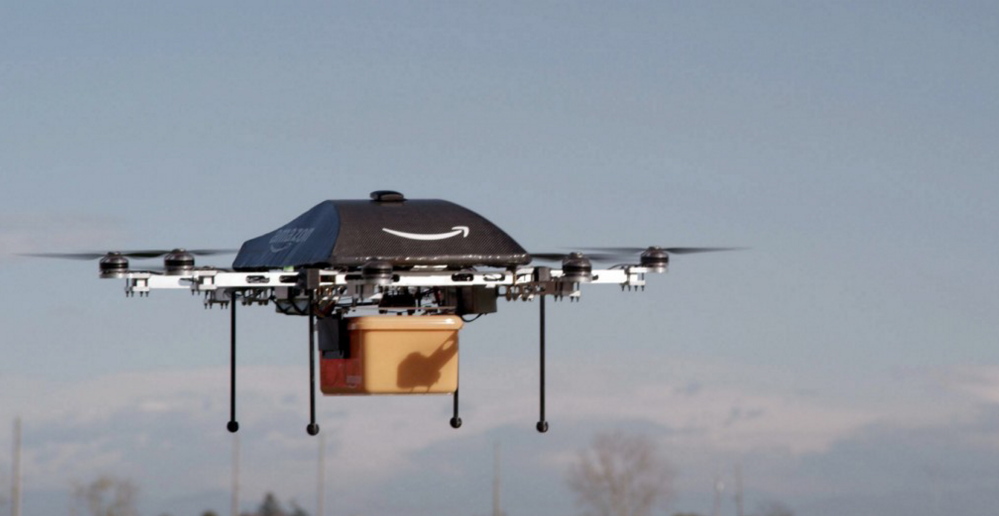In the quest to build drones that can help companies like Amazon.com make door-to-door deliveries, engineers are racing to overcome a fundamental challenge: helping unmanned, suitcase-sized aircraft see where they’re going.
The answer is developing sensors that are smart enough to keep the drones from smacking into buildings, people and anything else that would impede travel, yet small and light enough that the machines can stay aloft.
Startups around the U.S., eager for a slice of a market projected by Teal Group to more than double to $11.6 billion by 2023, are responding. Aurora Flight Sciences is testing echo location, a method that mimics how bats navigate in the dark, while engineers at 3D Robotics are turning to optic flow sensors, which detect objects by examining video pixels.
“Sense and avoid is one of the biggest opportunities in the industry,” said Jesse Kallman, chief of global business development for Airware, a drone-equipment maker backed by Google Ventures. “The technology is not there yet, but it’s something the industry needs badly.”
Size is the key to success and the smaller the better. Sagetech has reduced transponders, which send and receive signals on aircraft location, to the approximate dimensions of credit cards. In Alaska, a serial entrepreneur has licensed a miniature radar system, the technology considered most difficult to shrink because of the need for an antenna and a receiver.
Amazon Chief Executive Officer Jeff Bezos pushed the concept of home-delivery drones to the forefront in a Dec. 1 interview on CBS’ “60 Minutes,” saying Amazon plans to use small, helicopter-like aircraft to deliver packages as heavy as five pounds within a 10-mile radius.
U.S. airspace regulations for drones are just starting to take shape. There are still “serious unanswered questions” about the safety and reliability of unmanned aircraft, a National Academy of Sciences panel said Thursday. A report from the group cited “many substantial barriers” to integrating unmanned aircraft into U.S. airspace, including technology, a regulatory system unprepared to oversee them and privacy questions.
Preliminary rules due by year’s end from the U.S. Federal Aviation Administration may let drones weighing 55 pounds or less fly below 400 feet and within sight of a licensed operator.
The first commercial applications probably will be tasks such as surveying crops, filming movies and inspecting bridges and flare stacks that are difficult and dangerous to reach. In public safety, small aerial robots will help police diagram auto accidents and firefighters highlight hot spots during a blaze. Those duties are extensions of the way the military pioneered using unmanned aircraft for surveillance and strike missions.
Harnessing the full potential of drones, such as Bezos’s vision of robot aircraft lugging Amazon purchases, will require the ability to fly on autopilot and beyond the line of sight. There will be too many of them for remote pilots to control directly and for authorities to monitor.
Amazon is flight-testing fifth- and sixth-generation drones for its Prime Air program and is in the design phase for the next two versions, said Mary Osako, a spokeswoman for the company.
To give small drones the sensing capabilities of jumbo jets, Sagetech has shrunk the transponder for aircraft location to 3.5 ounces from about 3 pounds, President Kelvin Scribner said. In two years, Sagetech plans to produce a unit to let drones avert collisions with other aircraft. That system will weigh 7 ounces, or only about 5 percent as much as the equipment on a commercial airliner.
The challenge doesn’t stop there: Sensors still need refinement so low-flying drones dodge the trees, streetlights and humans that aren’t in the path of conventional planes.
Optical flow sensors, which let a computer mouse function without a trackball, are being adapted for collision avoidance. While that equipment is cheap and getting more sophisticated, it doesn’t work well in the dark or thick fog.
Terrence McKenna at Aurora is working on a fog solution. His team has equipped drones with echo-location sensors to keep the machines from bumping into a concrete pillar, for example, while inspecting a bridge.
Send questions/comments to the editors.



Success. Please wait for the page to reload. If the page does not reload within 5 seconds, please refresh the page.
Enter your email and password to access comments.
Hi, to comment on stories you must . This profile is in addition to your subscription and website login.
Already have a commenting profile? .
Invalid username/password.
Please check your email to confirm and complete your registration.
Only subscribers are eligible to post comments. Please subscribe or login first for digital access. Here’s why.
Use the form below to reset your password. When you've submitted your account email, we will send an email with a reset code.